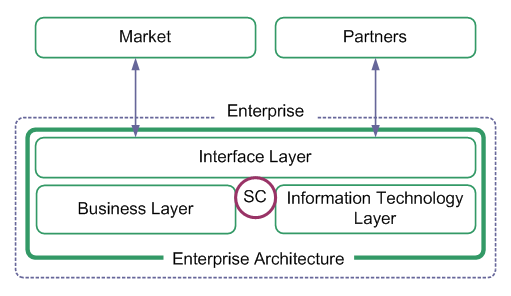The obscured forest behind architectural trees
In this article we discuss the proliferation of architectures and we present our high level view of enterprise architecture to try to demystify architectural complexity.
You have undoubtedly heard the terms Enterprise Architecture, Business Architecture and IT Architecture. These terms have become buzzwords in organisations across the world. Enterprises discuss how this or that architecture aligns with corporate strategy and what governance structures should be in place. Based on reading different articles on the subject, I tend to think that the architectural diversity is an obstacle for these discussions.
Demystifying architectural complexity
To get a clear picture of the pain with an architecture, let’s have a look at it from the organisational viewpoint.
Information Technology layer
I think nobody will argue that a contemporary organisation of any size depends on IT. IT is an integral part of any organisation. And yet, people on the IT side are sometimes not concerned with understanding what business processes and business functions in general they need to enable and support to ensure symbiosis and co-operation within the organisation.
Business layer
An organisational structure, allocation of business functions and their underlying business processes to business units and business interfaces with the organisation’s environment are at the heart of the Business layer. The Business layer is concerned with high availability of IT services supporting the business processes during business hours (applications, networks and communication means), with little concern about what it takes to run and support those IT services.
Interface layer
A common area of concern for the business and IT personnel is the interaction of the organisation with external parties (government, market bodies and suppliers/partners).
The common pain for these layers is that they are not well orchestrated to work in unison and deliver great business value and ensure sustainability of the organisation. So what would fix the problem?
Orchestrating performance

A very high level view of the enterprise architecture. Note the pivotal role of the service catalog which accumulates information about every layer.
The common ground or a platform for the aforementioned layers is the Enterprise Architecture (EA). Why is that? The Enterprise Architecture is concerned with ensuring that all the pieces fit well together, are non-conflicting and align with business objectives, whatever they are. The core pillar of the Enterprise Architecture is the Service Catalogue (SC) accumulating information about all layers.
The Enterprise Architecture is responsible for smooth functioning of the organisation regardless of the nature of changes to each layer. The Enterprise Architecture ensures that any existing solutions and components within the organisation are re-used as much as possible to realise the changes in a cost effective way and with minimal disruption to the business. This approach enables stability of functioning and a well managed organisational environment.
Executive Decision Making
The model above supports executive decision making as it enables quick assessment of any new business initiative or external change (risks, impact, costs and benefits). It is possible because any layer is not isolated but instead an integral part of the organisational mechanism. It supports cross-functional coordination across business units within the organisation.
All involved parties easily see how the proposed changes may alter the existing state and what communication plans should be put in place to ensure acceptance of the changes and smooth transition to the new state.
Conclusion
The goal of the described approach is to make explicit what layers of the organisational architecture are, overcome misalignment of business demand and organisation’s capabilities, and to facilitate active collaboration within the organisation itself as well as with its external environment.
Seeing the source of a change gives great visibility of the affected layers to the executives, thus enabling them to make sound decisions beneficial to their organisations and the wider business community.

New! We have published a new book: A Navigator to Business Analysis.
Over 400 pages of practical, useful material will help you build your skills and advance your career! Find out more and get free excerpt.
Get helpful BA articles in your inbox
Hone your skills with BA insights (and very occasionally, we may let you know about discounts and specials).